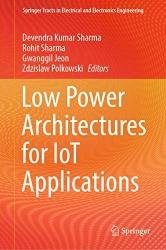 Название: Low Power Architectures for IoT Applications
Название: Low Power Architectures for IoT ApplicationsАвтор: Devendra Kumar Sharma, Rohit Sharma, Gwanggil Jeon
Издательство: Springer
Серия: Springer Tracts in Electrical and Electronics Engineering
Год: 2023
Страниц: 270
Язык: английский
Формат: pdf (true), epub
Размер: 36.9 MB
This book provides comprehensive coverage of different aspects of low-power circuit synthesis for IoT applications at various levels of the design hierarchy, starting from the layout level to the system level. For a seamless understanding of the subject, the basics of MOS circuits have been introduced at the transistor, gate and circuit level, followed by various low-power design methodologies, such as supply voltage scaling, switched capacitance minimization techniques, and leakage power minimization approaches. The contents of this book are useful to students, researchers, as well as practicing engineers. Low-power architectures refer to the latest development in computer microchips which are created by integrating hundreds of thousands of transistors on one chip for different IoT applications. Emerging research in this area has the potential to uncover further applications for IoT in addition to system advancements.
The IoT paradigm was initially described as a new dimension added to the field of information and communication technologies that enables connections for everyone and anything, anytime, and anywhere to create a new dynamic network of networks. The IoT is not a new trend anymore. With applications in numerous areas, including civil infrastructure, environment monitoring, energy, transportation, smart buildings, healthcare, defense, manufacturing, and production, it has emerged as one of the most significant technologies of the current century. IoT is still expanding. According to the State of IoT Q4/2020 and Outlook 2021 reports, there will be over 30 billion IoT connections by 2025, which equates to nearly four IoT devices per person.
One of the biggest challenges for IoT is smart energy management. Every active IoT network component needs to consume a certain amount of energy to operate. Despite using few energy resources, the amount of data produced by IoT has significantly increased recently. As a result, wireless communication devices’ batteries quickly discharge and regularly need to be replaced.
Batteries have historically been the most practical option for powering electronic devices, but when combined with tiny sensors that are used in a variety of environments, their disadvantages become more apparent. These disadvantages include the difficulty of replacement and recharging, biological incompatibility with the human body, and high environmental contamination. These limitations severely restrict the growth of wireless sensor nodes and IoT systems, which prompts new research approaches toward self-sustainability that are being attained through energy harvesting and self-powered sensing technology.
Contents:
Скачать Low Power Architectures for IoT Applications
